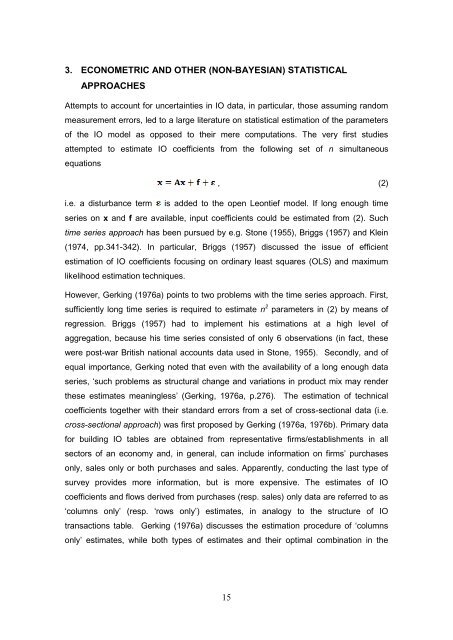Uncertainty treatment in input-output analysis
ifDakU
ifDakU
Create successful ePaper yourself
Turn your PDF publications into a flip-book with our unique Google optimized e-Paper software.
3. ECONOMETRIC AND OTHER (NON-BAYESIAN) STATISTICAL<br />
APPROACHES<br />
Attempts to account for uncerta<strong>in</strong>ties <strong>in</strong> IO data, <strong>in</strong> particular, those assum<strong>in</strong>g random<br />
measurement errors, led to a large literature on statistical estimation of the parameters<br />
of the IO model as opposed to their mere computations. The very first studies<br />
attempted to estimate IO coefficients from the follow<strong>in</strong>g set of n simultaneous<br />
equations<br />
, (2)<br />
i.e. a disturbance term is added to the open Leontief model. If long enough time<br />
series on x and f are available, <strong>in</strong>put coefficients could be estimated from (2). Such<br />
time series approach has been pursued by e.g. Stone (1955), Briggs (1957) and Kle<strong>in</strong><br />
(1974, pp.341-342). In particular, Briggs (1957) discussed the issue of efficient<br />
estimation of IO coefficients focus<strong>in</strong>g on ord<strong>in</strong>ary least squares (OLS) and maximum<br />
likelihood estimation techniques.<br />
However, Gerk<strong>in</strong>g (1976a) po<strong>in</strong>ts to two problems with the time series approach. First,<br />
sufficiently long time series is required to estimate n 2 parameters <strong>in</strong> (2) by means of<br />
regression. Briggs (1957) had to implement his estimations at a high level of<br />
aggregation, because his time series consisted of only 6 observations (<strong>in</strong> fact, these<br />
were post-war British national accounts data used <strong>in</strong> Stone, 1955). Secondly, and of<br />
equal importance, Gerk<strong>in</strong>g noted that even with the availability of a long enough data<br />
series, „such problems as structural change and variations <strong>in</strong> product mix may render<br />
these estimates mean<strong>in</strong>gless‟ (Gerk<strong>in</strong>g, 1976a, p.276). The estimation of technical<br />
coefficients together with their standard errors from a set of cross-sectional data (i.e.<br />
cross-sectional approach) was first proposed by Gerk<strong>in</strong>g (1976a, 1976b). Primary data<br />
for build<strong>in</strong>g IO tables are obta<strong>in</strong>ed from representative firms/establishments <strong>in</strong> all<br />
sectors of an economy and, <strong>in</strong> general, can <strong>in</strong>clude <strong>in</strong>formation on firms‟ purchases<br />
only, sales only or both purchases and sales. Apparently, conduct<strong>in</strong>g the last type of<br />
survey provides more <strong>in</strong>formation, but is more expensive. The estimates of IO<br />
coefficients and flows derived from purchases (resp. sales) only data are referred to as<br />
„columns only‟ (resp. „rows only‟) estimates, <strong>in</strong> analogy to the structure of IO<br />
transactions table. Gerk<strong>in</strong>g (1976a) discusses the estimation procedure of „columns<br />
only‟ estimates, while both types of estimates and their optimal comb<strong>in</strong>ation <strong>in</strong> the<br />
15


